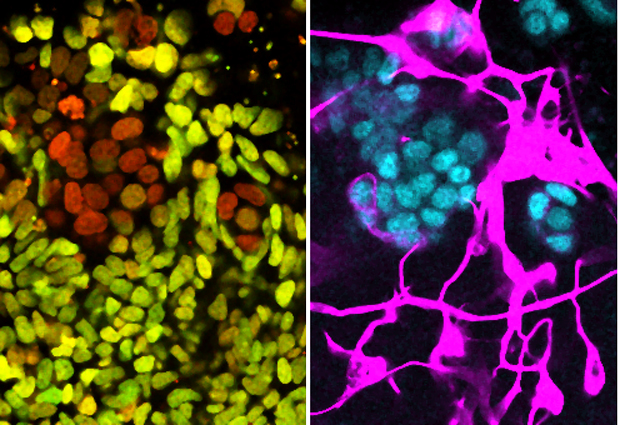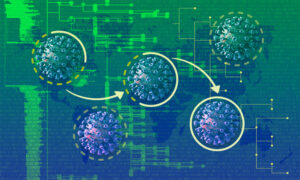Forever young
This ‘before and after’ image could be thought of as stem cells’ equivalent of an advert for anti-wrinkle cream: ‘look how cells stay young!’

It shows that a molecule called microRNA-142 allows stem cells to remain unchanged, instead of growing into specialised cell types. Given the right conditions, stem cells with low levels of microRNA-142 (green, left) grow into neurons (pink, right). But stem cells with high levels of the molecule (red, left) remain unchanged (blue, right), scientists at EMBL in Heidelberg, Germany, have found.
“It seems that this microRNA leaves the cells deaf to their environment: you can ‘throw’ whatever you want at them, and they don’t care: they carry on being stem cells,” says Pierre Neveu, who led the work.

The finding, published in Molecular Systems Biology in December, could have implications for cancer treatment and regenerative medicine, as well as more fundamental research. Hanna Sladitschek, a PhD student in Neveu’s lab, found that this microRNA suppresses a gene that can turn cells into tumour cells. And it blocks two chain reactions that have also been linked to cancer. “So you could think of delivering the microRNA to cells to prevent tumours from spreading,” Neveu postulates.
For colleagues working in regenerative medicine, the knowledge could bring increased safety and efficiency. If researchers growing tissue from stem cells in the lab removed cells with high levels of miRNA-142, they would reduce the risk that the tissue they implant back into patients still contains stem cells, which can develop into tumours. And selecting which cells to keep based on their levels of miRNA-142 could also considerably shorten the time needed to grow such tissues.
To make the discovery, the EMBL scientists refined a method to measure, very precisely, how much of a given microRNA is in a cell, and make those differences visible under the microscope.
Interestingly, cells with very different amounts of miRNA-142 show no discernible difference in gene activity. “That’s kind of the beauty of it,” says Neveu: “if you want to switch from stem cell to differentiating cell, you can do it very quickly, just by producing this microRNA. You don’t need to change your whole gene expression programme.”

Although the current study was based on growing cells in lab dishes, Neveu and colleagues have very strong indications that this also happens in live mouse embryos. As well as investigating the effects of miRNA-142 in mouse embryos further, the lab now plan to take a more systematic look, to see if other microRNAs play a similar role in keeping other types of stem cell ‘forever young’.



